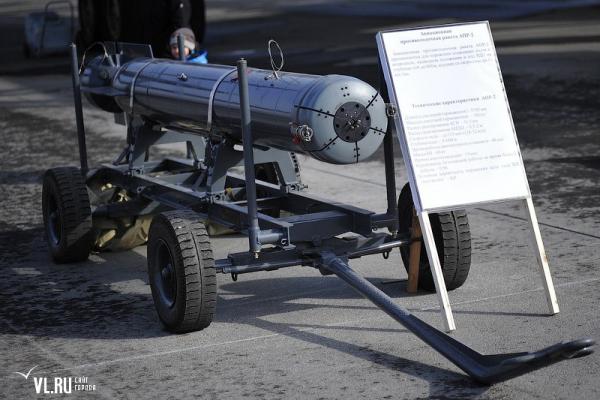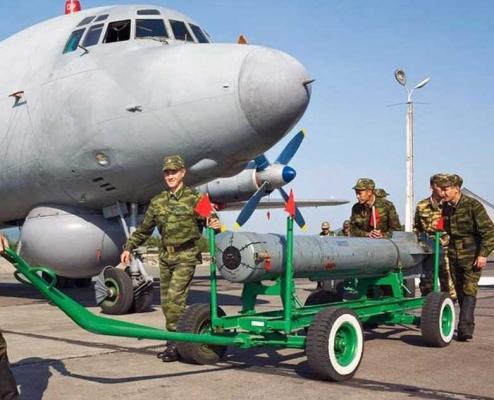APR-2/APR-2M Yastreb anti-submarine missile is designed to engage modern submarines, including multipurpose nuclear missiles, at speeds up to 43 knots in the submarine (at depths up to 600m), periscope and surface positions, as well as surface ships.
The missile was developed by a cooperation of enterprises headed by the SNPP "Region" as a part of the company: Research and Development Institute, Tomsk Research Institute of Economics and Technology, Leningrad Research Institute "Search", Design Bureau of Petrovsky Plant, Perm NPO named after Kirov, Moscow Research Institute "Quantum" on the basis of APR-1 "Condor". Chief Designer M.Lisichko.
Marine testing of the APR-2 began in 1969. State tests of the product with the modernized control system "Hawk-M" were completed in 1976, in the same year the product under the designation APR-2M was adopted for service.
Carriers: - antisubmarine helicopters: Ka-27PL, Ka-28, Mi-14PL - aircraft: IL-38, Tu-142M, Tu-142M3.
Export modification of the missile, designated APR-2E "Hawk-E" was released in 1984.
Further development of the APR-2 is an aircraft anti-submarine missile with turbojet engine APR-3/APR-3M "Eagle".
Composition:
The torpedo (see diagram) consists of the head fairing, instrument compartment with guidance and control instruments, combat unit, engine, steering compartment and brake system. The engine is RDT with high-calorie blended fuel.
Guidance and missile control system - inertial with homing system (HMS). Used CSS of hydroacoustic type with application of combinations of correlation-phase processing of incoming information and methods of coordinated filtration with amplitude selection. The applied decisions provide joint work of CSS and engine installation.
The combat unit is a blast part, weighing 80 kg. Fuse - non-contact acoustic. Compared to APR-1, the combat unit is equipped with a new explosive charge of increased power. Development of BC - GosNIIMash, production - Novosibirsk artificial fibre plant.
An APR-2 aircraft missile is dropped from a carrier in the intended target area. The brake system is triggered and the rocket torpedo is driven before being driven. Then the torpedo at an angle of 17 ° begins to dive with the simultaneous execution of circulation, with the motor system of jet torpedo is in the OFF state, CNS operates in passive mode. The dive is carried out to a maximum depth of 150 meters, if the missile has not detected a target during this time, the engine is switched on and the target is searched in active mode. When the homing system detects an underwater target, it bearings it and remembers the data. The reactive torpedo begins to move in the direction of the target from the memorized data using the inertial guidance system. Once the torpedo has travelled a certain distance from the target, it uses the homing system to refine the target location data (active mode is used) and continues moving in the target direction.
During operation, the torpedo is monitored by the AKIPS-1 automatic control station.
Characteristics:
| APR-2 | |
| Weight, kg | 575 |
| Caliber, mm | 350 |
| Length,mm | 3700 |
| Range, m | 1500-2000 |
| Speed of travel, km/h - underwater search - maximum |
43 knots (80 km/h) 62 knots (115 km/h) |
| Depth of stroke, m | 15 - 600 |
| Reset height from the medium, m | 300-2000 |
| Carrier speed when used, km/h | up to 800 |
| Target Speed | up to 43 knots |
| Parameters of hydroacoustic homing system: - search sector by horizon, m - vertical search sector, m - active-mode response radius on submarines, m - active mode response radius on surface ships, m - response radius in passive mode, m - signal/noise resolution - direction finding accuracy |
45° 90° up to 1500 up to 1000 up to 500 0.4 up to 2° |
| Weight of combat unit, kg | 80 |
| Battle unit charge (in TNT equivalent), kg | 100 |
| Depth of safety removal, m | 20 |
| Probability of hitting the target with a target designation error of 500m RMS | 0.70-0.85 |
| Time to complete a combat mission, min. | 1-2 |
| Self-liquidation time, min. | 15-20 |
Testing:
According to the data as of 17.11.2010, Rosoboronexport specialists also offered the Bal-E coastal missile system to foreign customers. The maximum range of the X-35E missile he used was 120-130 km.
During 2011, some officers of the coastal missile division of the Caspian Flotilla studied the new mobile coastal missile system "Bal-E" at special courses of the manufacturing plant.
For the creation of the Bal-E Coastal Missile Complex, by Presidential Decree No. 669 of 23.05.2011 a group of employees of the Tactical Missile Arms Corporation was awarded state awards and honorary titles.
For their great contribution to the development, creation and production of special equipment and many years of conscientious work, the Order of Merit for the Fatherland Medal, 2nd Class, was awarded to Vladimir Avrutskiy, Deputy Director General for Quality, Vitaly Klimchenko, Head of the Department of Nonprofit Organization of the Design Bureau, and Yuri Samoshkin, Leading Designer of the Design Bureau.
For merits in the field of design activity and many years of conscientious work, the honorary title "Honoured Designer of the Russian Federation" was awarded to Viktor Khaidukov, Deputy Head of Department - Head of Department of 110 Design Bureau.
For services in the field of mechanical engineering and many years of conscientious work, the honorary title "Honored Machine Builder of the Russian Federation" was awarded to the head of KIS Vladimir Kartoshkin.
In 2014, the Crimea was transferred to the coastal anti-ship complexes "Bal" from the 11th Separate Coastal Missile and Artillery Brigade of the Coastal Troops of the Black Sea Fleet (stationed in the village of Utash near Anapa).
The starting export customer of the complex "Ball" was to be Libya, but because of the civil war that began in the country in March 2011, President Dmitry Medvedev by his decree imposed an embargo on the supply of military products.
The Ball complex is operated by the Vietnamese armed forces.
Interest in the complex was shown by representatives of the armed forces of Azerbaijan and Venezuela.
Sources:
- Роман Джерелейко. Вооружение отечественной противолодочной авиации — АПР-2.
- С.Прошкин, В.Маринин. Российское торпедное оружие.
- Авиационная противолодочная ракета АПР-2 «Ястреб-М». День ВВС на Камчатке (А.А.Пирагис)
- АПР-2 Ястреб




